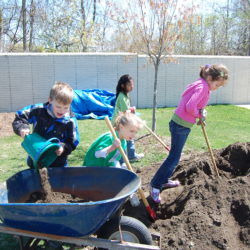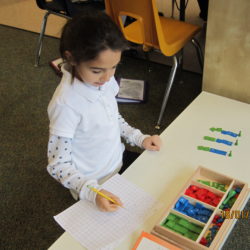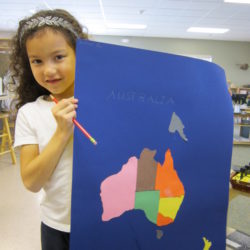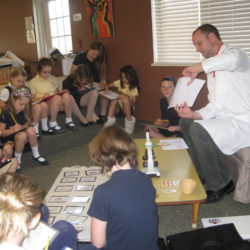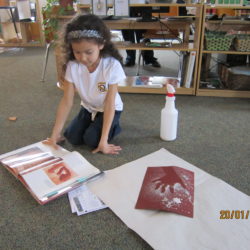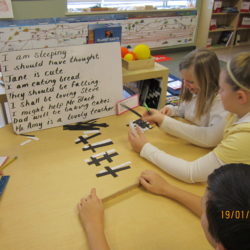Overview of the Philosophy
Elementary (Level 1-8)
Maria Montessori’s methods evolved from her scientific observations of children and their interactions with others and their environment. She discovered that children possess an innate love of learning and inner drive to grow and “self-construct,” and that this natural drive to learn can be fostered through interaction with a specially prepared environment.
Dr. Montessori deeply respected children as unique individuals and viewed the primary goal of education as the development of a complete human being. To her, a child was not a vessel into which predetermined levels of knowledge were poured, but a whole person who would develop and grow to his/her potential in all areas of life. She believed that all aspects of the human self (cognitive, social, emotional, spiritual and physical) were important, interrelated and inseparable. Thus, the Montessori approach is not only an educational philosophy, but a way of encountering the world and engaging with life.
Maria Montessori’s ideas were based on the understanding that a child’s education must be viewed in its entirety — from one developmental stage to the next — a learning continuum where each step builds on the previous. Montessori teachers are trained to introduce and re-introduce a carefully planned sequence of lessons, broken into many steps for a gradual movement from the concrete to the abstract. The Montessori elementary curriculum is by nature, interdisciplinary. It is carefully structured and integrated to tie the separate disciplines of the curriculum together into studies of the physical universe, the world of nature and the human experience. There is emphasis placed on drawing connections between different areas of study versus the mere presentation of isolated facts. Dr. Montessori referred to this approach as Cosmic Education.
The elementary student wants to explore the larger universe through the use of imagination and reason. The elementary curriculum is specifically designed to incorporate that explosion of curiosity and imagination. The Montessori elementary curriculum is built around the five Great Lessons: the creation of the earth; the coming of plants and animals; the arrival of humans; the history of language and writing; and the invention of math. They are intended to give children a holistic perspective of the earth. The law and order of the universe gradually become clear to the children through each successive story.
The Montessori elementary curriculum encompasses the full mastery of basic skills, and goes well beyond, to promote independent thinking and creativity. In addition, Montessori imparts other valuable life lessons such as how to work with others; peaceful resolution of conflicts; teaching and leading others; service to the community; ethical and social responsibility; and stewardship of the earth.
Oxford Academy Assessments
In the lower and upper elementary programs (6-9) and (9-12), our children approach test-taking as a practical life skill. We assess the third year students with a national standardized test.
Language Arts Goals for Elementary
Children at the end of Elementary should be able to read and discuss chapter books and are expected to have familiarity with children’s literature. They should know the parts of speech: noun, article, adjective, verb, adverb, conjunction, preposition, pronoun, and interjection. They are expected to be able to analyze sentences, to identify the subject and predicate of a sentence, and to identify direct and indirect objects. By the end of the Elementary cycle, children should be able to print neatly, write legibly in cursive, do descriptive writing, and do beginning level narrative. They should be able to read and participate in grand group discussions.
Math Goals for Elementary
Using concrete Montessori materials, children in Elementary are introduced to the concepts of the four operations of arithmetic: addition, subtraction, multiplication and division. Children are expected to master basic addition, subtraction, and multiplication facts by the end of the three year Elementary cycle. They should also be in the process of memorizing division facts. In many cases, children can do long addition, subtraction, and single digit multiplication problems abstractly (i.e. on paper without using Montessori materials).
The golden bead material presents the hierarchy of the decimal system in a concrete manner. As a result, Elementary children are comfortable with large numbers and are expected to do arithmetic with values in the millions using the Montessori materials. Fractions are introduced using concrete materials and children begin addition and subtraction operations with fractions.
Children are exposed to measurement of the physical properties of matter (length, weight, area, temperature), including English and metric units for length. Building on an introduction to plane and solid geometry from their time at the Children’s House, children continue to study geometric nomenclature. Children should be able to recognize coins and bills and count money; to tell time using an analog clock; and to read bar graphs and pie charts in conjunction with word problems.
Geography and the Physical Sciences
The combined area of geography and the physical sciences is a broad-based interdisciplinary subject in a Montessori classroom. It encompasses lesson and work activities traditionally identified as physical geography, economic geography, astronomy, social studies, social sciences, and political science.
Children in the Elementary program learn about the solar system, the parts of the universe, the nature of the elements, the characteristics of air, the earth’s orbit around the sun, the earth’s composition, and the seasons.
Through map work, the children learn to identify the continents and the countries of Europe, Asia, Africa, North American and South. Map work on the United States includes identifying the state names, the state abbreviations, the state flags, and the state capitals.
Economic geography introduces children to the various goods and services produced throughout the United States and in different geographical regions. These activities also allow the children to identify different ways goods and services are distributed. In addition, the Elementary geography curriculum provides a rudimentary exposure to government.
Observing experiments; performing experiments; using command cards; and writing command cards are also part of the geography program.
Biology
The biology work done in the Elementary program falls under the topics of botany and zoology.
Botany materials and lessons allow the children to study the different parts of the plant, such as the leaf, the root, the stem, and the seed.Nomenclature material and real specimens are used to introduce the children to each part of the plant as it is being studied. The children can make leaf collections, grow small plants, dissect seeds, dissect stems, etc. as part of their work in botany.
Classification activities are also part of botany. For example, children will sort and identify different types of leaves, types of stems, and types of roots using the nomenclature material and real plant parts. The Botany Cabinet is also used for identifying and sorting. It shows the children the different shapes of leaves and their names (e.g. chordate, obchordate, ovate, elliptical, linear, reniform). When using the Botany Cabinet, children trace the various leaf shapes from the Botany Cabinet and name them. Afterwards, they can match what they traced to actual leaf samples.
Zoology materials and work activities compare vertebrates and invertebrates. With classification material and through their own projects, children practice naming and identifying both. The five classes of vertebrates (mammals, fish, birds, amphibians, and reptiles) are introduced. Work with the Body Function Material allows children to compare and contrast the different classes of vertebrates. In addition, animal research allows for many areas of inquiry and exploration on an independent basis. Habitats, camouflage, adaptation, diet, lifestyle, and key characteristics are topics the children commonly learn about while doing animal research.
Dr. Reineke came to visit the elementary classrooms and gave instruction of the parts of the microscope and proper handling. Our new microscopes to enhance all areas of our science curriculum were donated by the Munaco and Zender families.
History Curriculum — an Overview
The Montessori approach is a three-year cycle of learning where the Montessori child learns at his/her own pace. The Directress/Director (teacher) prepares many materials in Montessori and this is most evident in the study of history. The desire to research a topic is natural for child in the Montessori classroom. The Directress/Director is the guide and the one responsible for providing the child the environment to fulfill the rich subject of history. The children do not use textbooks to guide them through the eras of history, but rather they research various ages of history, read literature (biographical, fiction, and non-fiction) that reflect particular times or particular historic figures, and share their knowledge with each other. Two important aspects of a child sharing knowledge with another child are: (1) the child imparting the knowledge demonstrates what he/she knows, and (2) the listening child is often times prompted to conduct his/her own research due to the interest sparked by the presenter. The listener’s research may not be on the same topic as what was presented but may very well be an offshoot of the topic, thus expanding the scope of learning within the classroom community.
History in Elementary
The study of history begins with the concept of time (how to tell time) and the passage of time (the duration of time and man’s existence therein). The Elementary child is exposed to the universe, the solar system, and the development of the earth. Timelines are a basic resource for directing learning in Montessori. The student is introduced to the timeline of life on earth. This timeline covers the discovery of the earliest forms of life, the Prehistoric Era, the study of fossils, and the study of early man. Maria Montessori defined that each civilization of man had a basic set of what she termed Fundamental Needs of Man (physical, spiritual, food, shelter, clothing, and defense).
The Montessori child identifies and uses the Fundamental Needs of Man throughout his/her study of history. It is this commonality of man that leads the child to appreciate what our predecessors have accomplished and given to us. The natural historical evolution leads the child to search out the customs and traditions that define a particular time. Elementary students are exposed to key figures of history, government, and organizations through group discussions, current events, and community events.
Grammar Curriculum
The study of grammar begins almost immediately after the child begins to read, during the sensitive period when he is spontaneously interested in language. It continues over several years until mastered. The idea is to introduce grammar to the young child as she is first learning how to put thoughts down on paper, when the process is natural and interesting, rather than waiting until the student is much older and finds the work tedious.
We introduce our children to the function of the parts of speech one at a time through many games and exercises that isolate the one element under study. Montessori has assigned a geometric symbol to represent each element of grammar. (For example, verbs are represented by a large red circle.) The children analyze sentences by placing the symbols for the appropriate part of speech over each word. Once students have mastered the concrete symbols for the parts of speech, they perform more advanced exercises for several years with grammar boxes set up to allow them to analyze sentences by their parts of speech. Sentence analysis: simple and compound sentences, clauses, verb voices, and logical analysis of all sorts of sentences are studied using many different concrete materials and exercises. This normally begins about age 5 and continues over several years. Students continue their study of language from the mid-elementary years onward, reviewing as well as engaging new concepts and skills: tenses, moods, irregular verbs, person and number, the study of style, the study of grammatical arrangements in other languages.
The children work through several grammar sorting boxes independently or with a guide’s assistance including:
- Nouns – singular/plural/masculine/feminine/irregular
- Articles – definite/indefinite
- Adjectives
- Verbs
- Adverbs
- Pronouns
- Prepositions
- Conjunctions
- Interjections
Playground Fun
The elementary students directed, wrote, and starred in this adaptation of Hans Christian Andersen’s’ Steadfast Tin soldier… during recess.

